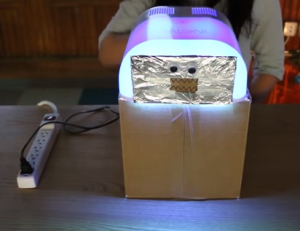 Stereolithography printers are lovely, aren’t they? They’re fast, they’re smooth, and they create great detail. Post-processing can be a bit of a bother, though. SLA pieces tend to need additional curing after they’ve finished printing, as most of them don’t completely harden; there’s usually some sticky resin that hasn’t fully cured while printing. There are many ways of curing the print after it’s taken off the printer: water and sunlight, UV lamps, etc. Some printer manufacturers sell devices for post-print curing, but a quick look online will show you that there are plenty of ways to make your own curing devices.
Stereolithography printers are lovely, aren’t they? They’re fast, they’re smooth, and they create great detail. Post-processing can be a bit of a bother, though. SLA pieces tend to need additional curing after they’ve finished printing, as most of them don’t completely harden; there’s usually some sticky resin that hasn’t fully cured while printing. There are many ways of curing the print after it’s taken off the printer: water and sunlight, UV lamps, etc. Some printer manufacturers sell devices for post-print curing, but a quick look online will show you that there are plenty of ways to make your own curing devices.
I never really thought about it before, but the tacky surface of an uncured print is similar to nail polish that just won’t dry. SLA printer manufacturer Formlabs noticed this, though, and it gave them an idea – why not hack a nail dryer to make a UV cure box? Instead of using the idea to build a new product to sell, the company helpfully created a video to teach you to build one yourself for under $30.
Required supplies include:
 Tinfoil
Tinfoil- Box cutter
- Scotch tape
- Box tape
- Pencil
- UV nail lamp
- Solar powered rotating mini display
- Cardboard box
- Most importantly – googly eyes
Most of those supplies can be found at your local hardware or office supply store, obviously, and you can buy a rotating mini display stand and a UV nail dryer inexpensively on Amazon. Make sure your box is large enough, because, according to Formlabs, thin parts could warp if they are too close to the UV bulbs.
 First, remove the base of the nail dryer and trace around it on the side of the box, then cut out the part you’ve just traced – this will be where the nail dryer is mounted. To make sure your eyes are protected from the UV light, take the excess piece of cardboard, wrap it in tinfoil, and use it to cover the front of the nail dryer; the light will be reflected back into the box instead of in your eyes.
First, remove the base of the nail dryer and trace around it on the side of the box, then cut out the part you’ve just traced – this will be where the nail dryer is mounted. To make sure your eyes are protected from the UV light, take the excess piece of cardboard, wrap it in tinfoil, and use it to cover the front of the nail dryer; the light will be reflected back into the box instead of in your eyes.
Next, cover the entire inside of the box in tinfoil, making sure that the shinier side of the foil is facing inward. Tape it securely. Then, remove the turntable of the solar powered display stand and cover that in tinfoil before reattaching it. Place the rotating display inside the box – this is where your printed part will sit – and place the nail dryer over the opening you cut out of the box. Last, but not least, draw a monster face on the nail dryer and add googly eyes – important for keeping your curing print from trying to escape. When you’re ready to use your cure box, just place your part inside, turn on the nail dryer, and you’re in business. Let us know if you take on this project in the $30 DIY Cure Box forum on 3DPB.com. For a more thorough, visual instruction, take a look at the video below:
Subscribe to Our Email Newsletter
Stay up-to-date on all the latest news from the 3D printing industry and receive information and offers from third party vendors.
You May Also Like
Further Understanding of 3D Printing Design at ADDITIV Design World
ADDITIV is back once again! This time, the virtual platform for additive manufacturing will be holding the first-ever edition of ADDITIV Design World on May 23rd from 9:00 AM –...
3D Printer Maker EVO-tech Reborn as NEVO3D — Once More With Feeling
EVO-tech was a 3D printing service and original equipment manufacturer established in 2013 and based in Schörfling am Attersee, Austria. The company produced high-quality material extrusion systems featuring linear bearings,...
3D Systems Brings 3D Printed PEEK Cranial Implant to the U.S. with FDA Clearance
For more than 10 years, 3D Systems (NYSE:DDD) has worked hand-in-hand with surgeons to plan over 150,000 patient-specific cases, and develop more than two million instruments and implants from its...
CDFAM Returns to Berlin for Second Annual Symposium
The second CDFAM Computational Design Symposium is scheduled for May 7-8, 2024, in Berlin, and will convene leading experts in computational design across all scales. Building upon the first event...































